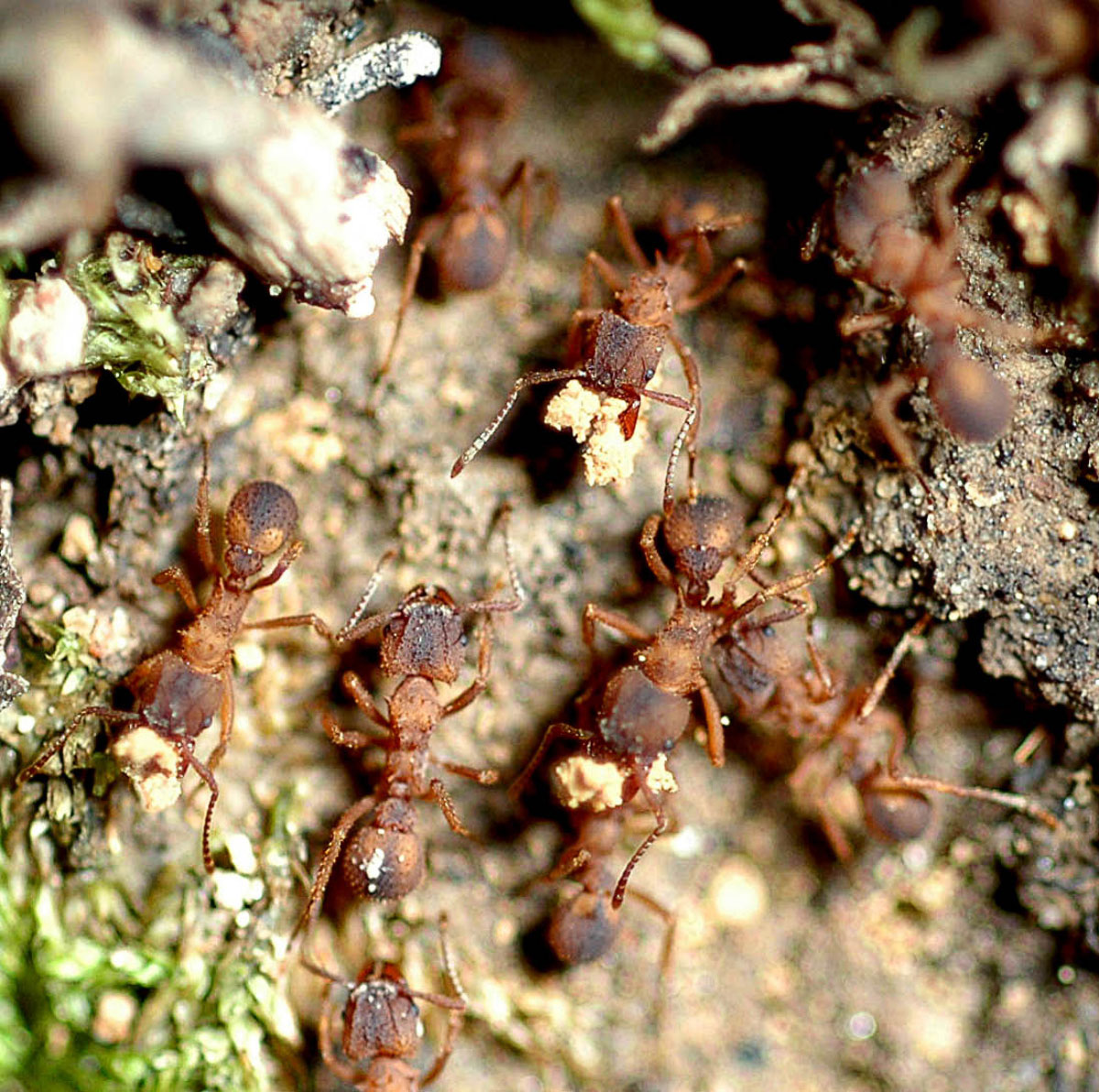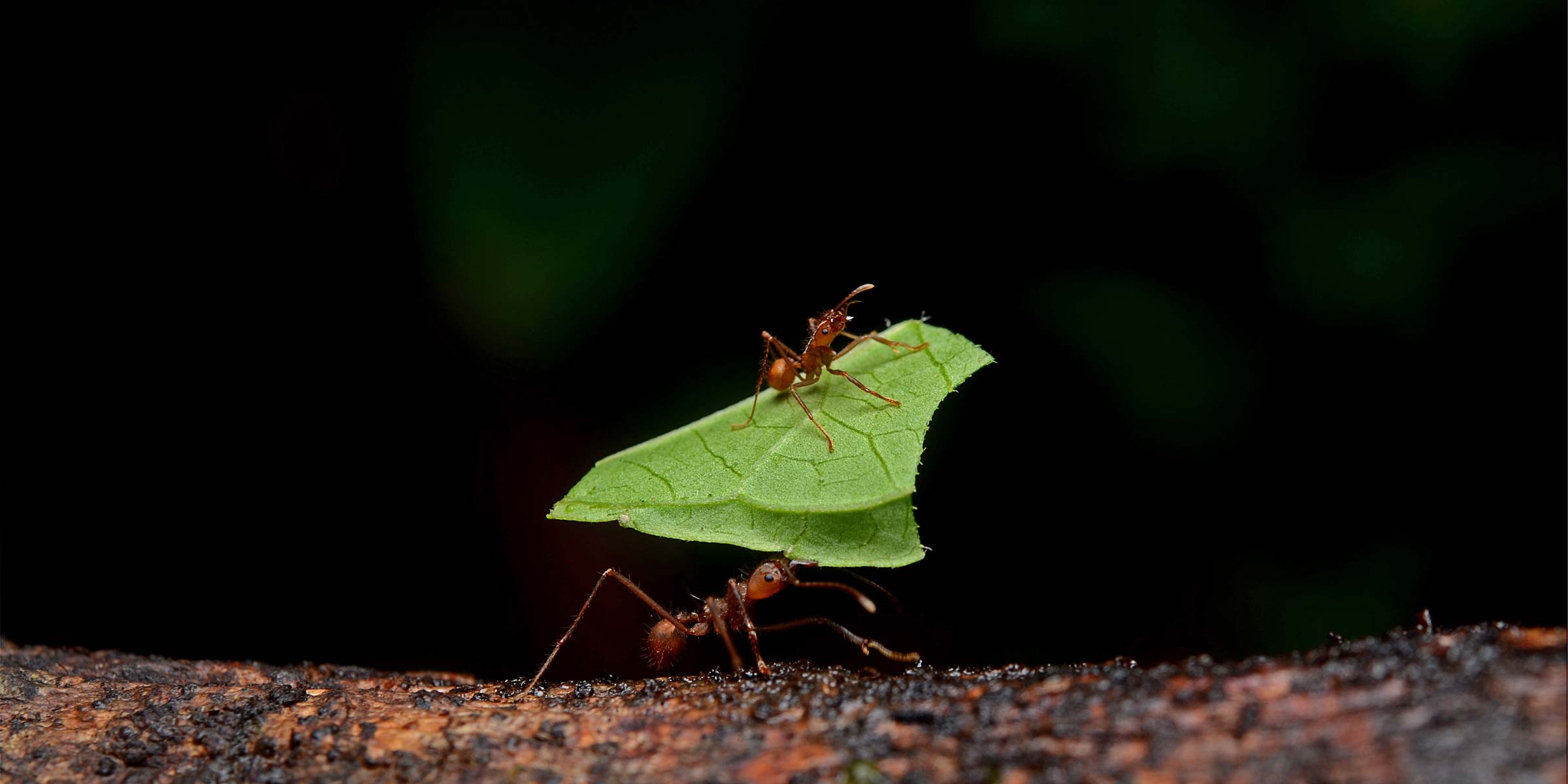Approximately 10,000 years ago, the development of agriculture was crucial to the ecological success of the human species, favoring the proliferation of individuals and the occupation of vast areas of the planet. A similar process occurred with ants, only long before. More than 50 million years ago, ants in the tribe Attini began to cultivate fungus (tribe is the taxonomic classification between the definition of family and genus). They began to use leaves, flowers, bits of twigs, and seeds as a growing medium to cultivate fungus, which forms the foundation of their diet.
Of the 14 genera of ants that comprise tribe Attini, the most successful from an ecological point of view are the leafcutters, which belong to the genera Atta and Acromyrmex. They dominate all of the Americas and make enormous nests with millions of individuals; some are so expansive that they can be seen in photos taken by satellites in space.
For a long time, environmentalists thought that the leafcutters owed their success to their particular way of cultivating food. Leafcutter ants are unique in using fresh, green leaves they cut with their powerful jaws as the growing medium for their fungus gardens, while the other ants in the tribe Attini use dead leaves and decaying organic material to produce their food. Since in nature living leaves are more plentiful than dead ones, leafcutter ants have a greater potential for population growth than ants that depend on decomposing material to feed themselves. The dominant idea was that in this green growing medium, which contains more nutrients than dead leaves, leafcutters cultivated only one type of food: fungi in the species Leucocoprinus gongylophorus. According to the most widely accepted theory, leafcutter ants emerged over the last 19 million years and coevolved alongside this fungus, generating a relationship of mutualism.
Today, a study by Brazilian and American biologists published in May in the journal Molecular Ecology contradicts this belief. “The idea that each group of ants cultivated only one species of fungus was something well established. But our study shows that the ants are open to new partnerships, and that these exchanges do not alter the ecological success of the species,” says pharmaco-biochemist Mauricio Bacci Júnior of the Center for Social Insect Studies at São Paulo State University’s Rio Claro campus (UNESP). Bacci was one of the leaders of the study, which involved seven universities. It considered ecological as well as genetic data from more than 40 species of leafcutter ants found ranging across the entire span of the Americas.
The study also reinforces the hypothesis that the leaf-cutting ants originated in South America
Bacci explains that the fungus Leucocoprinus gongylophorus, which had been believed to be specific to leafcutter nests, was found in colonies of ants in the genus Trachymyrmex, which are also within tribe Attini but have an intermediate behavior between leafcutter ants and those that do not cut leaves: these ants use green leaves as well as decomposing organic matter as a growing medium. He also thinks that the fungus which was given the same name as the Trachymyrmex ants (specifically because it was thought to be exclusively cultivated by this genus) may need to be renamed since it has now been identified in nests of another leafcutter, Atta laevigata. “We have come to the conclusion that the ecological success of ants—and, consequently, also their destructive impact on agriculture—cannot be attributed to harvesting a specific super-fungus,” says biologist Ulrich Mueller of the University of Texas, coauthor of the study.
“There is an underground ‘trade’ in fungi. The ants do what we do with agricultural products: they exchange fungal species with each other and select the most nutritious,” Bacci explains. “In one single region, a few kilometers away it is possible to find the same ant species with different fungus species.” The ant-fungus relationship is mutualist (both benefit), but the complex interactions that are present in the nest are still not well understood. Bacci reports that these fungi grow slowly in the laboratory. “The ants grow them very well, we still need to learn from them.”
The article published in Molecular Ecology cites previous research with similar results. The most surprising came in 2015, in a collaboration involving Bacci and Mueller. “In the Amazon we found the ant Apterostigma megacephala, a rare species which usually grows one of the most primitive free-living fungi known, producing and eating the fungus of the leafcutter ant, Leucocoprinus gongylophorus,” says biologist Heraldo de Vasconcelos of the Federal University of Uberlândia (UFU), one of the authors of the study. “The most interesting contribution of this study was to present a large quantity of evidence that the coevolutionary process between the leafcutter ants and this fungus was more diffuse than had been imagined,” states Vasconcelos.

Alexander Mikheyev
Leafcutter ant of the species Atta texana in its “fungal garden”Alexander MikheyevBut it is not only the ability to cultivate various species of fungi that defines the ecological success of these ants. Their ability to maintain such numerous colonies in areas with a wide range of climate, vegetation, and soil also depends on two other factors: meticulous hygiene, and cooperation with bacteria which eliminate fungi that can harm the nest. “These ants are very vigilant and carefully clean each leaf they bring into the nest, removing the spores of fungi that would compete with the ones they cultivate,” says entomologist Odair Correa Bueno, professor at UNESP in Rio Claro.
In an experiment together with biologist André Rodrigues, a specialist in fungi, Bueno and his team infected colonies of Atta sexdens with fungus of the genus Syncephalastrum. As soon as they identified specimens of this harmful microorganism, the worker ants removed them and brought them to a disposal area, according to an article published in 2017 in Pest Management Science. When the workers were removed, the colony sickened.
In a previous study which was also part of a project coordinated by the chemist João Batista Fernandes of the Federal University of São Carlos (UFSCAR), Bueno and Ribeiro confirmed that the bacteria found in Trachymyrmex leafcutter ants produce compounds that act against invading fungi such as those in the genus Escovopsis, which compete with the fungal gardens. “The leafcutters have a microbiota that helps in defending against other microorganisms,” he says. “For this reason, at this time no strategy has been found for biological control of these ants.”
A South American ancestor
The study published in Molecular Ecology also reinforced the hypothesis that the ancestral species of leafcutter ant was South American. “A species has its most likely origin in a place where there is more biodiversity. Hence the appearance of this theory,” explains Bacci. Studies by the Argentinean Nikolai Kuznezov in 1963 and Harold Fowler of UNESP’s Rio Claro campus in 1983 argued that leafcutter ants originated in meridional South America (southern Brazil, Argentina, Uruguay, and Paraguay).

Paul Davison/University of Northern Alabama
The fungus cultivated by ants in the genus Trachymyrmex (above), which had been thought to be unique to this group, was found among leafcutter ants in the species Atta laevigata laboreroPaul Davison/University of Northern AlabamaIn 2016, a study published in PLOS ONE by the biologist Maykon Passos Cristiano of the Evolutionary Genetics and Populations Laboratory at the Federal University of Ouro Preto (UFOP), came to a similar conclusion. “In evolutionary terms, the first species of leafcutter ant to separate from the other ants in tribe Attini would have been Acromyrmex striatus, which occurs in these drier, more open environments in South America,” he says.
Another theory is being tested by recent studies: that leafcutter ants emerged in more humid environments like the Amazon or Central America. For example, this is the hypothesis of a 2017 study by researchers from the Smithsonian Institute in the United States. But for Mueller, the scope of current work undertaken in partnership with the group from UNESP leaves little room for doubt: “Our extensive collection of leafcutter ant fungi strongly supports Kuznezov and Fowler’s hypothesis,” says Mueller.
These conclusions came from genetic studies of fungus samples collected from sites ranging from Argentina to the United States. Also used were 2,500 samples of more than 40 species of leafcutter ants preserved in ethanol at -80°C in Bacci’s laboratory at UNESP and Mueller’s lab in Austin, Texas. To establish the phylogeny (the evolutionary relationship between individuals), the samples underwent DNA sequencing. “This methodology is widely used in evolutionary studies that seek to understand the kinship relationships and diversification of species or lines. What needs to be emphasized in this work is the astounding quantity of biological material used,” adds UFOP’s Cristiano, who did not participate in the article in Molecular Ecology.
“Studies of this size can only be completed through work by multidisciplinary teams from more than one laboratory, through extensive international collaboration,” emphasizes entomologist Jacques Hubert Charles Delabie of the Federal University of Bahia (UFBA). For Delabie, access to samples which were geographically well distributed over two continents and then analyzed by researchers from several specialties made the conclusions more secure. “This study brings together all the knowledge already published on these issues and there are many publications, since this is an extremely dynamic area,” he says.
Commercial potential
The biologist Mariane Aparecida Nickele, who is completing a postdoctoral internship at the Federal University of Paraná (UFPR), hopes that such detailed studies will also be performed on other microorganisms that live together with ants. “Other microorganisms are part of this system, such as the parasitic fungus in the genus Escovopsis, filamentous bacteria like Pseudonocardia, and the black yeast in the genus Phialophora,” she says. Nickele believes it is also necessary to understand the role these microorganisms play in their symbiosis with the ants, because they could be useful in the discovery of new molecules of interest to medicine or industry. “If we can understand the ‘agricultural technology’ of these ants, we will be able to produce chemicals of commercial interest in the laboratory,” says Bacci. In his opinion, the ants’ fungi can convert plant biomass into polyols like sorbitol and arabitol, substances which have a high market value and are mainly used as artificial sweeteners.
To confirm these possibilities, more studies need to be completed. According to Bacci and Mueller, populations of leafcutter ants from South America still need to be sampled in the same density as those from Central and North America in order to generate a complete picture of the biogeography of associations between fungi and ants in this region. “We anticipate that the greatest advances in understanding the evolution of leafcutter ants will emerge from further studies of species from southern South America,” predicts Mueller.
Projects
1. Processing of substrates by Attini ants: Dynamics and metabolic cooperation with microorganisms (no. 14/25507-3); Grant Mechanism Regular Research Grant; Principal Investigator Mauricio Bacci Júnior (UNESP); Investment R$224,987.87.
2. Integrated studies for the control of leafcutter ants (no. 12/25299-6); Grant Mechanism Thematic Project; Principal Investigator João Batista Fernandes (UFSCAR); Investment R$4,042,561.80 (for the entire project)
Scientific articles
MUELLER, U. G. et al.Phylogenetic patterns of ant–fungus associations indicate that farming strategies, not only a superior fungal cultivar, explain the ecological success of leafcutter ants. Molecular Ecology. v. 27, p. 2414–34. 2018.
BARCOTO, M. O. et al.Pathogenic nature of Syncephalastrum in Atta sexdens rubropilosa fungus gardens. Pest Management Science. v. 73, n. 5, p. 999-1009. Mai. 2017.
MEIRELLES, L. A. et al.Broad Escovopsis-inhibition activity of Pseudonocardia associated with Trachymyrmex ants. Environmental Microbiology Reports. v. 6, n. 4, p. 339-45. 2014.


